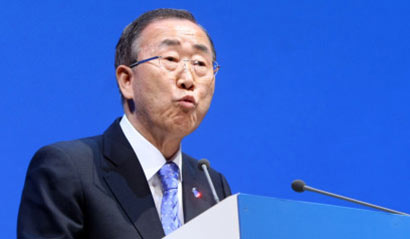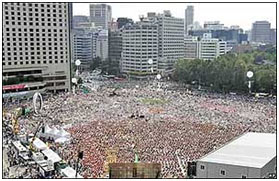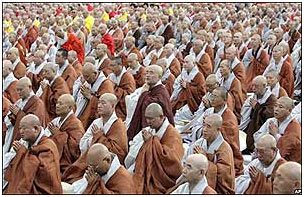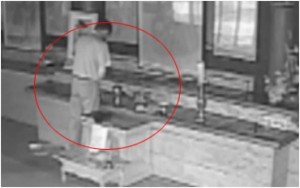UNHRC turns blind eye to attacks on Buddhist Temples in South Korea

– by Shenali D. Waduge –
South Korea voted against Sri Lanka on March 27 at the UN Human Rights Council (UNHRC) in Geneva in support of a US Resolution calling for an international inquiry to be undertaken by the Office of the High Commissioner on alleged Human Rights violations by Sri Lanka. In taking this path South Korea showed itself as the ONLY Asian nation to have aligned with the Christian West bloc of nations alongside nations scared of the West, to vote against Sri Lanka. All other Asian countries either voted against the Resolution e.g. China, Pakistan, Vietnam, Maldives, Saudi Arabia, UAE or abstained e.g. India, Indonesia, Japan, Kazakhstan, Kuwait, Philippines.
This is the second time that South Korea has voted against Sri Lanka at UNHRC having done so on a similar Resolution last year (2013) proposed by USA and the EU block of nations. Sri Lanka if it is to retain its dignity and self – respect particularly in the Asian community must now undertake a critical assessment to determine who its true friends and ‘cosmetic’ friends are in the international arena.
It follows that the Govt. of Sri Lanka should no longer give the red carpet to the countries that voted for the US Resolution and against Sri Lanka. Other Asian countries e.g. Japan, Philippines, Indonesia etc. too have strong ties with USA but they also value their ties to a fellow Asian nation through religious, cultural and historical bonds. South Korea took a unilateral stand disregarding these ties to Sri Lanka.
Is South Korea functioning as a surrogate of the Christian West in Asia?
South Korea is promoting an International Conference of Asian Political Parties (ICAPP) Sept. 18- 21, 2014, to be held in Colombo with Sri Lanka playing host. The main theme of the conference is “Building an Asian Community.” Both the Govt. and people of Sri Lanka have every right to ask South Korea whether an Asian Community could be truly established in situations where one Asian country stabs another Asian country in the back by joining hands with European nations which always vote as one block in International fora. South Korea has a lot of explaining to do if it wants Sri Lanka to look at South Korea as a true friend. No amount of money can compensate for betrayal of friendship.
In the meantime Sri Lanka has a duty by its people and particularly the Ranavirus (gallant soldiers) who won the war for Sri Lanka against a cruel enemy by sacrificing 27, 000 of Ranaviru lives to take tough decisions even in the international arena. Sri Lanka must seriously consider hosting this International Conference of Asian Political Parties (ICAPP) in Colombo in September 2014 sponsored by South Korea. Its Asian credentials and commitment towards building a truly Asian Community are now suspect. Is South Korea functioning as a surrogate of the Christian West like so many NGOs who rely on financial assistance from the West for their political and economic survival while doing the bidding of the West in de-stabilising Asian countries?
Unceasing attacks on Buddhist Temples in South Korea
South Korea is also the home of Ban Ki Moon, the present UN Secretary General who is a devout Christian. South Korea’s population is 50million. In 1945 Korea was a 90% Buddhist country. Approximately 2% of the population was Christian. Rapid growth has ensued for Christianity: in 1991, 18.4% of the population (8.0 million) was Protestant, and 6.7% (2.5 million) was Catholic.
In 2005, according to figures compiled by the South Korean National Statistical Office, 46.5% of the population were classified as Irreligious, compared to 22.8% Buddhists, 18.3% Protestants, 10.9% Catholics, and 1.7% Other religions. The Catholic Church has increased its membership by 70% in the last ten years.
Today South Korea had the third highest percentage of Christians in East Asia or Southeast Asia, following the Philippines and East Timor.
It is indeed strange that with the UN and the UNHRC head Navi Pillai in particular drawing references to religious intolerance why they have been stoic silent on the unprecedented violent attacks upon Buddhist places of worship.
The Resolution against Sri Lanka drawn from the report by Navi Pillai expresses alarm at the rapid rise in violence and discrimination on the basis of religion or belief, particularly against members of religious minority groups. The Resolution urges the Government of Sri Lanka to investigate all attacks, by individuals and groups on all religious places of worship, hold the perpetrators responsible and prevent future such attacks.
The below examples of religious intolerance in South Korea happened and is happening for decades. South Korea is the home of the UN Secretary General himself, yet the emphasis against Sri Lanka with hardly 20 cases of violence in 5 years which themselves are questionable against Buddhist temples scorched and destroyed completely in South Korea only serves to raise the question of double standards at play. This is reiterated further in Navi Pillai’s silence over 700 mosque attacks in the UK.
In 2008, when 200,000 Buddhist monks and lay people rallied in Seoul, South Korea protesting against religious bias and constitutional infringement by the Lee Myung-bak administration not a hum came from Navi Pillai or the entities lining up to accuse Sri Lanka of religious intolerance. Of particular note was after Lee Myung-bak‘s ascendence to the Presidency when the high proportion of Christians in relation to Buddhists in the public sector became known–particularly the President’s cabinet, where there were 12 Christians to only one Buddhist.



Security camera footage of the priest urinating on the shrine at Donghwa Temple
http://enews.buddhistdoor.com/en/news/d/38161
Incidents highlighting Attacks on Buddhist Temples
- 1982 May – Religious gatherings in Seoul to publicly denounce Buddhism with banners ‘Jesus Heaven, Buddhism Hell’ & “A Dharma Hall is a hall of demons”.
- 1984 February – Red crucifixes are painted on priceless temple wall paintings at Muryangsa Temple and Ilsônsa on Samgaksan Mountain outside Seoul. Dirt is smeared on the paintings and on a statue of the Buddha located outside one of the temples. A large ancient carving of the Buddha chiselled into stone is damaged with axe-like instruments.
- 1984 May – Roman Catholic church ignores pleas of Buddhist leaders and invites Pope John Paul II to visit South Korea during Buddha’s Birth celebrations alongside announcement that 93 Koreans and 10 French missionary martyrs would be beautified as saints during visit with South Korea becoming the 1st canonization ceremony held outside Rome. The event placed South Korea as the 4th largest number of Catholic saints in the world.
- 1984 November – Official Korean textbooks describe Buddhism as ‘a fading religion’.
- 1985 April – 4 major daily newspaper carry advertisements promoting Buddhist scriptures are ‘selfish’ in intent.
- 1985 September – Mass gatherings organized to denounce Buddhism in cities of Pusan, Taegu, Kwangju, Taejon
- 1985 October – Dharma talk disturbed at Nûngin Zen driving nails into the tyres of vehicles parked outside and pouring corrosive chemicals into various car engines.
- 1986 December – Taejôkkwangjôn, the main Dharma Hall, a large building of ancient origin at Kûmsansa Temple is completely burned to the ground before the annual Buddha’s Enlightenment celebrations. The Hall is listed as National Treasure Number 476. The Korean Government releases the suspects but quickly rebuilds the Hall
- 1987 December – a fundamentalist Christian is apprehended after setting fire to 2 temples ( Kwanûmjôngsa and Taegaksa) and completely destroying them
- 1988 September – fire is set at Pômôsa Temple in Pusan, a major monastic training center of the Chogye Order and completely destroys the Myôngbujôn (Chijang Bodhisattva Hall- a funeral hall), taking with it 16 priceless altar paintings of the Buddha.
- 1988 December – main Dharma Hall on the Kyôngju campus of Dongguk University is completely burned to the ground.
- 1989 January – stone lantern and pagoda is destroyed and statements attacking Buddhism are painted on the temple’s gates Sôdaemun (Hongûndong), Seoul.
- 1989 March – individuals enter Kupok Am Hermitageon Samgaksan Mountain on the outskirts of Seoul and destroy a stone lantern and stone pagoda, seriously damage a Ch’ilsônggak (Big Dipper Hall), and paint red crucifixes on a large gilded Buddha statue.
- 1989 April – individuals destroy a Buddha statue and paint red crucifixes on a large outdoor Ma-ae Buddha figure carved into the rock on Samgaksan Mountain on the outskirts of Seoul. 10 temples are severely damaged or desecrated in the days immediately before and after the national Buddha’s Birthday holidays.
- 1989 July – huge main Dharma Hall and a temple dormitory at Potasa Temple, Oksudong, Sôngdonggu, Seoul are completely burned to the ground. Estimated damage is $1.1million.
- 1989 October – huge Taeunjôn, the main Dharma Hall, and a temple dormitory at Pohyônsa Temple in Taegu are completely burned to the ground.
- 1990 May – Two men break into the Buddhist Broadcasting System before it began broadcasting and destroy the radio station’s recordings and transmission equipment, smashing expensive electronic gear and tear up state-of-the-art recording booths. They use a statue of the Buddha as a battering ram and damaged computers using Buddha’s head. No arrests were ever made.
- 1991 April – 2 teachers at Taesông High School in Kôch’ang direct majority Buddhist students to recite Biblical passages and sing Christian hymns in class. Buddha statue of the Buddhist student club at Ch’ôngju University is vandalized.
- 1991 September – Pudo Am Hermitage at Tonghwasa Temple is destroyed by fire.
- 1991 October – Haeundae Buddhist Mission Bldg in Pusan is destroyed by fire. The huge main Dharma Hall (Taeunjôn) at Pongwônsa Temple in the Shinch’on district of Seoul is totally destroyed by fire. The hall was registered as Seoul city Cultural Asset Number 68. Three large Buddha statues and altar portraits considered treasures were destroyed This temple was the headquarters of the T’aego Order, the second-largest Buddhist sect in Korea. The police claimed no evidence and fire declared an ‘accident’.
- 1991 November – Military reserves stationed in Kyôngnam Province (many of them Buddhist) were forced to attend a Protestant revival meeting, presumably by a superior officer.
- 1991 November – Kwanûm Bodhisattva Hall and a large Dharma Teaching Hall (Sôlpôpchôn) at Sôngjusa in Changwôn city are completely burned to the ground.
- 1991 November – P’yo Ch’ajong, a member of the Pedel Church in Pusan, publicly declares that the world-famous Sôkkuram Buddha statue is a subject of “idol-worship” and the product of “a heretical religion”. He attempts to damage the priceless statue, but is stopped. The Sokkuram Buddha was declared a “World Cultural Treasure” by Unesco in 1995
- 1992 April – Main Dharma Hall on the Kyôngju campus of Dongguk University is completely burned to the ground a second time. No arrests made.
- 1992 December – unknown assailant cuts the two arms off a statue of Maitreya Buddha at Puljosa Temple in Wonju. Various temple artifacts are burned and over 100 threatening phone calls are made to the temple office.
- 1993 February – Colonel (battalion commander) Cho Pyôngshik of the 17th Tank Battalion, claiming a lack of warehouse space, has the Dharma Hall on his base dismantled. The gilded statue of the Buddha is taken from the Hall, burned, and openly discarded behind the mountain.
- 1993 April – Within two months of Colonel Cho’s actions, the Dharma Hall and stone lantern are damaged at Kimhae Air Base.
- The Yôngdo Church in Pusan organizes to prevent a temple from being built beside them, claiming that they “cannot accept the construction of a place of idol worship” near them.
- 1993 May – At Hyundai High School, all students are required to attend church services, and their attendance at these services is reflected in their school records.
- 1993 May – Lee Yun-sun, a teacher at the Paegun Primary School in Uidong, Seoul, teaches the Christian Bible in his class and declares that any Buddhist children in the class are “followers of the Satan,” and excludes them from certain class activities. Professor Im In-hûi rejects the admission application of a Buddhist student. He claims he was only following the orders of the board chairman of Taejôn Junior College Lee Pyông-ik.
- Lotus lanterns prepared for Buddha’s Birthday celebrations are destroyed at Pongguksa Temple and Chonjôngsa Temple in the Chôngnûng district of Seoul.
- 1993 July – An assailant severely damages Buddha statue and other Buddhist artifacts in a Buddhist meeting room at Sônggyungwan University in Seoul. Valuable religious objects are not stolen but thrown into a garbage basket.
- 1994 May – Before and after Buddha’s Birthday, various acts of vandalism and desecration are inflicted upon the properties of Daesôngsa Temple and Kwanûmsa Temple in the Saegômjông and Shinch’on districts of Seoul. Approximately 30 acts of vandalism against Buddhist temples in Seoul are recorded during this period.
- The Rev. Yu Sûng-hwan of Yuchongni Church declares that Buddhism is “idol worship.” He forcibly attempts to “convert” the abbot of Sudosa Temple to Christianity.
- 1994 June – A fundamentalist Christian enters Mirûk Chôngsa Temple in Kwangju and damages the Buddha statue and Dharma Hall.
- 1995 September – Pak Oh-Sun is apprehended after entering and causing serious damage to five temples on Chejudo. He burns Buddha statues at the temples. A Protestant minister is apprehended after painting a large red cross onto the altar painting behind the Buddha at Mu-ûi sa Temple in Kangjin, Chollanamdo. He is released without charges. Later an unknown person carves a crucifix below the same Buddha image.
- 1995-96 – Students belonging to a fundamentalist Christian group begin an aggressive campaign of proselytizing on the campus of Dongguk University (Seoul), Korea’s main Buddhist university. The students proselytize directly in front of a large statue of the Buddha – the campus symbol and central meeting-point – making anti-Buddhist statements and handing out Christian literature to ordained sangha members.
- 1996 – President Kim Young Sam attends services at a Protestant church located on the nation’s central military base at Kyeryôngsan Mountain. In an event which sends shock waves throughout Buddhist and Catholic circles in Korea, many troops (who were not Christian) based there are compelled to attend the service in order to create the appearance of a larger number of Protestant troops. People attending services at a nearby temple and Catholic church are placed under virtual “house arrest,” their religious sanctuaries being encircled with troops while the President makes what is deemed a “preferential” visit to the Protestant chapel. Those inside the Buddhist temple and Catholic church were made to remain inside for several hours while President Kim completed his visit. Buddhist and Catholic leaders lodge strong protests.
- 1996 – new Education Law are announced by the government’s Education Reform Committee. The plans are based on the educational system of the Renewal Church of Christ, and include plans to establish (with government money) a special graduate school for the education and training of Christian ministers.
- TheWônmi ward office of Puch’on city near Seoul sends official letters to several Buddhist kindergartens, primary schools, and other Buddhist organizations and temples. Language in the letters beseeches them to find “the peace of God and the comfort of Jesus Christ.
- The swastika – for centuries a symbol of good fortune throughout Asia, and also a Buddhist symbol of the same – is replaced on many flagpoles in Seoul with crucifixes.
- A large red crucifix is painted in a concrete shelter used by Buddhist monks for meditation, located one hundred meters above Hwagyesa Temple on Samgaksan Mountain on the outskirts of Seoul.
- A school teacher by the name of “Lee” at Songwu Primary School in P’och’ôn, Kyônggi Province, urges students to attend church services as part of their lessons. She forces them to sing certain Christian hymns in class to confirm their attendance, and does other “missionary work” in her capacity as schoolteacher.
- 1996 April – Fires set at 9 places including Pulguksa Temple in Kyôngju, the most famous Buddhist temple in Korea. A Mr. Kim Yông-shik was caught on the spot and reported to the police. The police transferred him to a Taegu city mental hospital and released without charge.
- 1996 April 19 – Two temples on Samgaksan Mountain on the outskirts of Seoul are severely damaged by fires. The two-year-old large bell platform at Samsông Am Hermitage is burned to its foundation. The assailant(s) also cause damage to the Main Dharma Hall, burning holes in the locked doors while trying to gain access to the sanctuary containing the temple’s main Buddha statue. Damage to the ruined bell platform is estimated at $250,000.
- 1996 April 20 – Two recently-constructed Dharma Halls at Pônwôn Chôngsa Temple are burnt to the ground, and another is severely damaged by flames. The Nahanjôn enshrined 519 wood statues of arhats and bodhisattvas, each of which was painstakingly hand-carved and hand-painted over a period of seven years. Damage at Pônwôn Chôngsa Temple is estimated at $5.6 million.
- 1996 April 21 – fire is set to the Taejôkkwangjôn, the main Dharma Hall at Hwagyesa Temple
- 1996 May 12 – Arsonists attack the main Buddha statue in the Taejôkkwangjôn at Hwagyesa Temple in Seoul for the second time.
- 1996 May 14 – despite over 30 police and military patrolling the temple, a massive fire is set beneath the main Buddha statue in the Taejôkkwangjôn at Hwagyesa Temple in Seoul for the third time. Superb altar paintings, ornate woodcarvings and traditional wall paintings are lost. Damage estimated at about $775,000.
- 1996 May – Rev. Pae Sông-ho, a Protestant minister, enters the main Buddha Hall at Ch’ôngryongsa Temple in Chinhae on the southern coast of the peninsula. He swings a microphone over his head like a bolo, smashing the main Buddha statue and damaging beyond repair the altar paintings hanging behind the main altar. Witnesses who apprehend him hear him shouting abusive statements about “idol worship” and that “now [he] will go to heaven for destroying these craven images.” Though taken into custody by police, the minister is released within hours with no charges filed by the local authorities. Damage to the Dharma Hall is extensive.
- 1996 May 22 – Two days before Buddha’s Birthday, the main Dharma Hall at Mangyông Am Hermitage in Sôngnam, a city bordering Seoul, is burned to the ground. Christian fundamentalists active in the area are suspected but not investigated.
- 1996 – July a mission to convert ’25 million Buddhists in Korea’ featured in the Christian newspaper Kitokkyo Shinmun,
Vandalized Temples Reveal Religious
Intolerance; Local Buddhist Leaders Condemn Acts of
Discrimination by Christian Extremists in South Korea
http://koreanstudies.com/pipermail/koreanstudies_koreanstudies.com/1998-July/000908.html
Buddhism Under Siege in South Korea
A Chronology of Fifteen Years of Incidents Against Buddhism in South Korea
They seek to destroy us
http://www.centrebouddhique.net/content/view/127/31/
https://groups.google.com/forum/#!topic/soc.culture.korean/ljmcyOVMh9Y
http://callingchristians.com/2012/11/07/korean-christians-attack-buddhists-and-buddhist-temples/
Korean Christians Attack Buddhists and Buddhist Temples
http://enews.buddhistdoor.com/en/news/d/38161
Korean Protestant pastor urinates inside Buddhist temple
https://www.facebook.com/pages/Save-Korean-Buddhism/193850150660564
Save Korean Buddhism
The example of religious intolerance is just one of the additional items included into the 3rd Resolution at UNHRC not included in the initial. A host of other additional items under human rights which attempts to mix humanitarian laws with human rights needs to get the attention of the global community to realize that a neocolonial agenda is now at play and when US and EU vote en masse the likelihood of fair play prevailing is bleak. In South Korea, the systematic destruction of the Buddhist heritage and Buddhist identity of South Korea has not got a single protest from the UN and its associated entities and it goes to show the lies and hypocrisies that prevail.
The example of growing religious intolerance against Buddhism in the very country that Ban Ki Moon comes from goes to show the shocking truth of using issues to the advantage of agendas by UN officials who are simply puppets and ever ready to do as the Christian West bids them to do.
It is now time that the rest of the world became aligned to build a formidable force against the new racial and religious imperialism emanating from the West.
Latest Headlines in Sri Lanka
- Clean Sri Lanka: 1,000 schools undergoing restoration nationwide February 20, 2025
- Cabinet Spokesman regrets Deputy Minister Sunil Watagala’s ‘Buruwa’ remark February 20, 2025
- No threat to national security from isolated incidents – Minister Ananda Wijepala February 20, 2025
- Amitha Wedisinghe passes away February 20, 2025
- Sri Lanka to review court security after Ganemulla Sanjeewa’s assassination February 20, 2025


